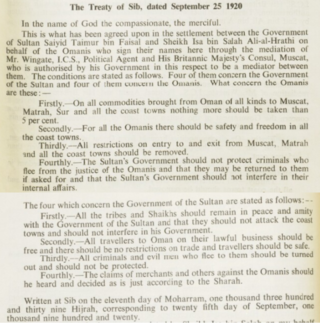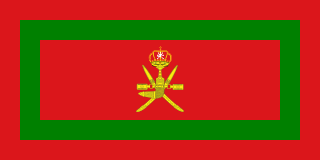
Oman, officially the Sultanate of Oman, is a country on the southeastern coast of the Arabian Peninsula in West Asia. It shares land borders with Saudi Arabia, the United Arab Emirates, and Yemen. The capital and largest city is Muscat. Oman has a population of about 5.28 million as of 2024, which is a 4.60% population increase from 2023. and is the 123rd most-populous country. The coast faces the Arabian Sea on the southeast, and the Gulf of Oman on the northeast. The Madha and Musandam exclaves are surrounded by United Arab Emirates on their land borders, with the Strait of Hormuz and the Gulf of Oman forming Musandam's coastal boundaries.

Oman is a site of pre-historic human habitation, stretching back over 100,000 years. The region was impacted by powerful invaders, including other Arab tribes, Portugal and Britain. Oman, at its height, held holdings that ranged from the Persian Gulf all the way south to the island of Madagascar, some notable holdings include; the island of Zanzibar, the city of Mogadishu and the city of Gwadar.

Islam is the state religion in Oman, introduced during Muhammad's lifetime in the early 7th century. Muhammad appointed Amr ibn al-As as governor, who remained until Muhammad's death in 632 CE. Amr and Sa'id ibn Aws al-Ansari delivered Muhammad's letter to the Al-Julanda brothers; the rulers of Oman, inviting them to embrace Islam. This peaceful mission marked the beginning of Islam in Oman. Today, 95.9% of Oman's population is Muslim, with slightly over 45% following Sunni Islam, and around 45% Ibadi Islam, with the other 5% identifying as Shia Muslims.

Sultan Taimur bin Faisal bin Turki Al Said was the Sultan of Muscat and Oman from 5 October 1913 to 10 February 1932.

Ghalib bin Ali bin Hilal al-Hinai was the last elected imam of the Imamate of Oman.

The Sultanate of Muscat and Oman, also known briefly as the State of Muscat and Oman during the rule of Taimur bin Feisal, was a sovereign state that encompassed the present-day Sultanate of Oman and parts of present-day United Arab Emirates and Pakistan, in the second half of the 19th century and 20th century. Ruled by the Busaid dynasty, it was established as a result of the partition of the Omani Empire upon the death of its last ruler Said bin Sultan. The Sultanate transitioned into a new form of government after the palace coup of 23 July 1970 in which the sultan Said bin Taimur was immediately deposed in favor of his son Qaboos bin Said.

The Treaty of Seeb was an agreement reached between the sultan of Muscat, Taimur bin Feisal, and the Imamate of Oman on 25 September 1920. The treaty granted autonomy to the imamate in the interior of Oman but recognized the sovereignty of the Sultanate of Muscat. The treaty was named after Seeb (as-Sib), a coastal town in present-day Oman.

The House of Al Bu Said, is the current ruling royal family of Oman, and former ruling house of the Omani Empire (1744–1856), Sultanate of Muscat and Oman (1856–1970) and the Sultanate of Zanzibar (1856–1964). It was founded by Ahmad bin Said Al Busaidi in 1744 and is currently headed by Haitham bin Tariq Al Said.

The Jebel Akhdar War, also known as the Jebel Akhdar Rebellion or the Oman War, broke out in 1954 and again in 1957 in Oman, as an effort by the local Omanis in the interior of Oman led by their elected Imam, Ghalib al-Hinai, to protect the Imamate of Oman from the occupation plans of Said bin Taimur, sultan of Muscat and Oman, backed by the British government, who were eager to gain access to the oil wells in the interior lands of Oman. Sultan Said received direct financing to raise an armed force to occupy the Imamate of Oman from Iraq Petroleum Company (IPC), a consortium of oil companies that was majorly owned by what is known today as Royal Dutch Shell, Total, ExxonMobil and British Petroleum (BP); the latter was majority-owned by the British government.

The Omani Empire was a maritime empire, vying with Portugal and Britain for trade and influence in the Persian Gulf and Indian Ocean. After rising as a regional player in the 18th century, the empire at its peak in the 19th century saw its influence or control extend across the Strait of Hormuz to modern-day Iran and Pakistan, and as far south as Cape Delgado. After the death of Said bin Sultan in 1856 the empire was divided between his sons into two sultanates, an African section ruled by Majid bin Said and an Asian section ruled by Thuwaini bin Said.
The Hināwī are one of two major tribal groupings of Oman and the Trucial Coast, the other being the Ghāfirī. Characterized as two significant factions having distinct interests and organizations, their rivalry began approximately 2000 years ago; almost during the time Ghafiris arrived to Oman. The Hinawis, for the most part, resided in southeast Oman, while the Ghafiris predominated in the northwestern part of Oman. Several tribal groups make up the Hinawi alliance, such as, the Dhowahir, Beni Yas, and the Awamir, Beni Hina and the Harasis. During the 18th century, serious conflicts occurred between the two factions. These conflicts only ended after many sub-tribes were united under one leader that belonged to one of the two factions. The Hinawis gathered under Khalaf bin Mubarak Alhinai from the Bani Hina tribe, while the Ghafiris gathered under Mohammed bin Nasir Alghafiri of the Beni Ghafir tribe. The almost equal strength of the two alliances led to the end of the feud. The rivalry played a decisive role in shaping the political history of Oman, with Omani tribes affiliating themselves historically with either the Ghafiri or Hinawi alliances.

The Yarubid dynasty were rulers of Oman between 1624 and 1742, holding the title of Imam. They expelled the Portuguese from coastal strongholds in Muscat and united the country. They improved agriculture, expanded trade and built up Oman into a major maritime power. Their forces expelled the Portuguese from East Africa and established long-lasting settlements on Zanzibar, Mombasa and other parts of the coast. The dynasty lost power during a succession struggle that started in 1712 and fell after a prolonged period of civil war.
Nasir bin Murshid was the founder of the Yaruba dynasty of Imams of Oman, a member of the Ibadi sect. He ruled from 1624 to 1649. He took power during a chaotic period when the former dynasty had collapsed and the interior of the country was lawless, while the Portuguese held the main coastal ports. In a series of campaigns he established his authority over the Omani tribes.
Saif bin Sultan II was the sixth of the Yaruba dynasty of Imams of Oman, a member of the Ibadi sect. He held the position of Imam four times during a chaotic period of civil war and invasion by Persian forces.

The Nabhani dynasty, members of the Bani Nabhan family, also referred to as the Sultans of Sohar, were rulers of Oman from 1154 until 1624, when the Yaruba dynasty took power. One of their most visible legacies is the Bahla Fort, a large complex of mud brick buildings on stone foundations built from the 12th to the 15th century. It was registered in 1987 as a UNESCO World Heritage Site.
The Muscat rebellion was an uprising in 1913 led by Sālim bin Rāshid al-Kharūṣī against the authority of the Sultans of Muscat and Oman. The rebels established their own state, the Ibāḍī imamate. Its causes lay in a deep-rooted rivalry between northern and southern tribes of Muscat and Oman. It began in May 1913 in Tanuf. On 5 June, the rebels captured Nizwa, and on 20 June they captured Izki. By this time, the rebels had also surrounded Samail. On 24 June, the rebels captured al-`Awabi. By July, the situation had gotten so dire that the British government sent a small garrison to Natrah to aid the sultan of Muscat, to no avail. In August, the rebels captured Samail. Also in August, the rebels launched an offensive towards the coastal side of al-Jabal al-Akhda, and Nakhl was besieged on the 4th. Nakhl ultimately fell at the beginning of April 1914, after the desertion of several of the imam's reinforcement contingents. In April 1914 British cruisers bombarded Barkah and Qaryat to dislodge rebels from those settlements.
Al-Salt bin Malik was the seventh Imam of Oman, ruling from 851 until his deposition in 885.
Fāṭima bint Aḥmad Muḥammad al-Jahḍamī, known as Fāṭima al-Suqutriyya and nicknamed al-Zahra on the model of the Prophet's daughter Fāṭima, for whom al-Zahra was a popular epithet, was a Yemeni writer and poet who lived on the island of Socotra in the third century AH. She is thought to be the first known Socotran poet.
Nur al-Dīn al-Sālimī was an Omani historian and scholar noted for his expertise in Ibāḍī Islam. Al-Sālimī is a very important figure in Oman with reference to his publications. Among his publications are Tuḥfat al-Aʿyān bi-sīrat ahl ʿUmān and Talqīn al-ṣibyān. Both references are taught in public schools.
Al-Julanda bin Masud was an Ibadi religious leader who was elected the first Ibadi imam of Oman, ruling from 749 until his death defending against an Abbasid invasion in 751 CE.














